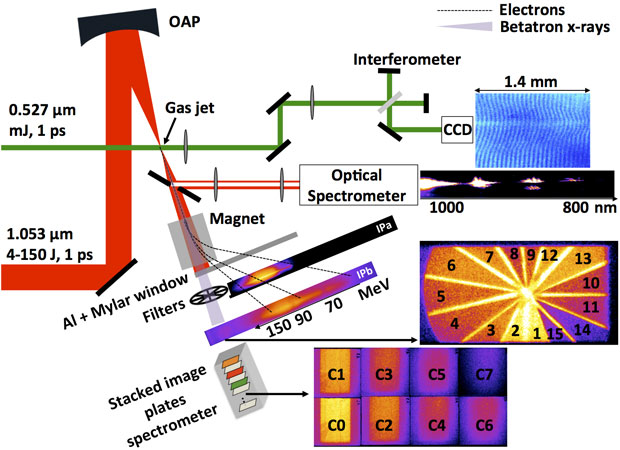Felicie Albert (16-ERD-024)
Project Description
Understanding material properties under extreme conditions of temperature and pressure is critical for a variety of physics fields, including astrophysics, high-energy-density science, and Inertial Confinement Fusion. High-energy-density science facilities such as LLNL's National Ignition Facility and the OMEGA laser at the Laboratory for Laser Energetics in Rochester, New York, are now uniquely able to recreate in the laboratory, conditions of temperature and pressure that were thought to be only attainable in the interiors of stars and planets. Developing efficient, versatile, and fast (sub-picosecond-scale) x-ray probes with energies larger than 50 keV is essential to diagnose such transient and extreme states of matter at these specific facilities. For instance, high-energy x rays are required to radiograph the dynamics of imploding fusion target capsules at the National Ignition Facility, or the temperature and pressure of warm dense matter via absorption spectroscopy or scattering techniques. We intend to extend the development of x-ray sources to four high-energy-density science facilities: the National Ignition Facility; OMEGA; the Megajoule Laser facility near Bordeaux, France; and the Titan laser at LLNL's Jupiter Laser Facility. Each of these lasers has unique characteristics that will allow us to explore complementary regimes of laser-driven electron acceleration and x-ray production. Our x-ray sources will be based on laser-wakefield acceleration, in which electrons are accelerated in a plasma wave created by the interaction of an intense laser pulse with a gaseous target. Our work will be the first demonstration of x-ray light sources driven by laser-wakefield acceleration on picosecond-scale lasers with energies above 200 J. The experiments will produce picosecond, collimated, broadband x-ray beams, as well as high-energy electron beams.
Although a large number of laser-wakefield acceleration x-ray experiments have been done in a regime where the laser pulse length is about half the plasma period, very little is understood about the characteristics of such sources on longer-pulse-duration (about 1 ps) facilities. No experiments have yet been done on this subject at major high-energy-density science laser facilities. In addition to providing a unique x-ray source for high-energy-density studies, our experiments will clarify the physics of laser-wakefield acceleration and subsequent x-ray radiation for picosecond, high-energy laser facilities. We expect our experiments will deliver picosecond, collimated, broadband x-ray beams beyond 50 to 100 keV, as well as high-energy electron beams up to the gigaelectron-volt level. In addition to extending the understanding of the physics of short-pulse, high-intensity laser interactions with plasmas, our project will result in a new and unique x-ray platform for scientists at the aforementioned high-energy x-ray facilities. These x-ray sources have unique properties that make them ideal probes and back-lighters for time-resolved spectroscopy; x-ray imaging; Compton radiography, which is used as a diagnostic in Inertial Confinement Fusion experiments; and Laue diffraction, which is used to determine crystal structure. Such experiments can help address a number of important physics issues related to shock physics, opacity, planetary sciences, and relativistic laser–plasma interactions.
Mission Relevance
Our proposed work will serve to make possible exploratory efforts into regimes of high-energy-density physics that have been hitherto unreachable, and provide insights into high-intensity laser–plasma interactions and laser-wakefield acceleration on picosecond timescales. This proposal is thus directly aligned with the LLNL's core competency in high-energy-density science, and will enhance the strategic focus area of inertial fusion science and technology.
FY16 Accomplishments and Results
During the first year of the project, we (1) performed theoretical and experimental studies, which demonstrated that we can efficiently use self-modulated wakefield acceleration to produce betatron x-ray radiation with picosecond-scale lasers; (2) performed simulations with the three-dimensional particle-in-cell code OSIRIS in collaboration with the University of California, Los Angeles; and (3) obtained experimental results on the Titan laser at 150 J and 1 ps (figure shows experimental setup), where we produced electrons up to greater than 200 MeV and x-ray spectra with critical energies of about 20 keV.
Publications and Presentations
- Albert, F., and A. G. R. Thomas, "Applications of laser wakefield accelerator-based light sources." Plasma Phys. Contr. Fusion 58(10), 103001 (2016). LLNL-JRNL-682217. http://dx.doi.org/10.1088/0741-3335/58/10/103001
- Albert, F., et al., Betatron x-ray radiation from a hybrid self-modulated wakefield and direct laser accelerator. (2016). LLNL-JRNL-701573.
- Albert, F., et al., Betatron x-rays from laser-wakefield accelerators: A novel probe for time-resolved HED science experiments. (2016). LLNL-ABS-680209.
- Albert, F., et al., Development and applications of betatron x-ray sources at JLF. (2016). LLNL-POST-666687.
- Albert, F., et al., Observation of betatron radiation in the self modulated regime of laser wakefield acceleration. 57th APS Division of Plasma Physics Mtg., Savannah, GA, Nov. 16–20, 2016. LLNL-CONF-679119.
- Lemos, N., et al., "Self-modulated laser-wakefield accelerator as an x-ray source." Plasma Phys. Contr. Fusion 58(3), 034018 (2016). LLNL-JRNL-697677. http://dx.doi.org/10.1088/0741-3335/58/3/034018






